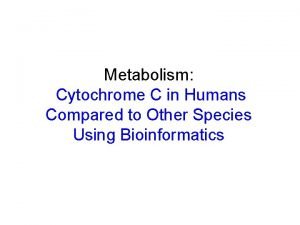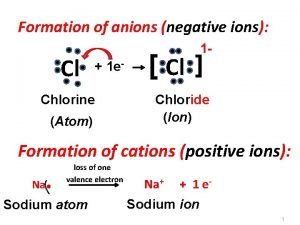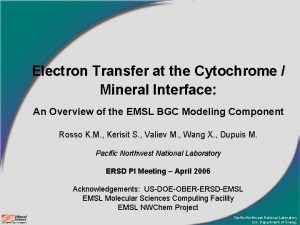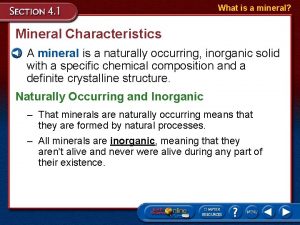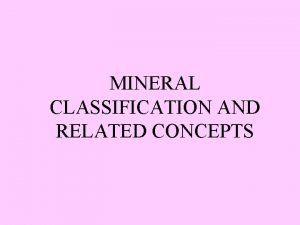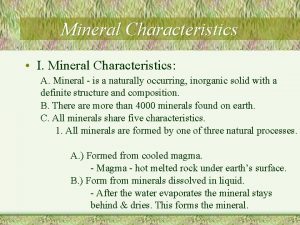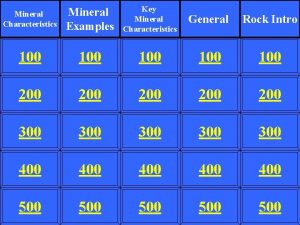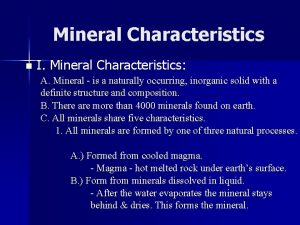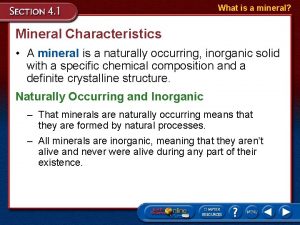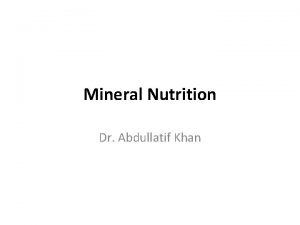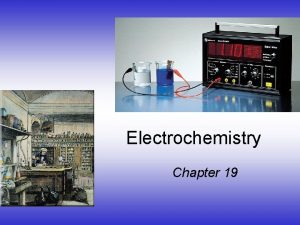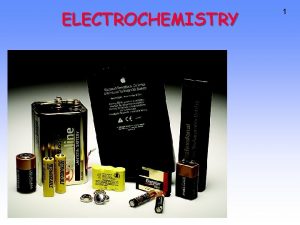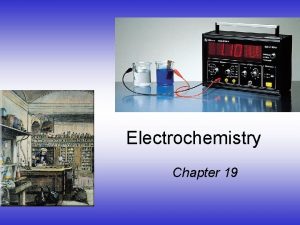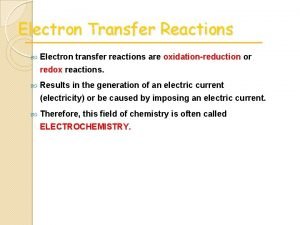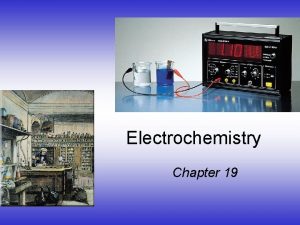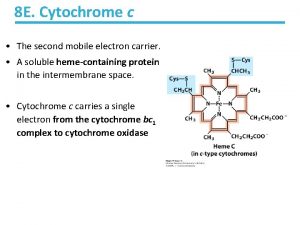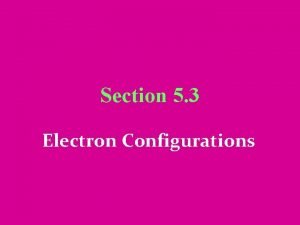Electron Transfer at the Cytochrome Mineral Interface An
























- Slides: 24

Electron Transfer at the Cytochrome / Mineral Interface: An Overview of the EMSL BGC Modeling Component Rosso K. M. , Kerisit S. , Valiev M. , Wang X. , Dupuis M. Pacific Northwest National Laboratory ERSD PI Meeting – April 2006 Acknowledgements: US-DOE-OBER-ERSD-EMSL Molecular Sciences Computing Facility EMSL NWChem Project Pacific Northwest National Laboratory 1 U. S. Department of Energy

Current Conceptual Model for Electron Transfer to Extracellular Substrates in Shewanella BGC Hypothesis: Outer membrane cytochromes Omc. A/Mtr. C are responsible for direct electron transfer to the Fe(III) oxide Courtesy - D. Richardson 2

Science Questions What regulates the ET rate across the cytochrome/Fe(III)-oxide interface? Bis-histidine heme How are Fe(III) acceptor sites ‘regenerated’ and how fast? Fe(II) e Fe-terminated hematite (001) e Fe(III) e 3

Obstacles / Challenges Aspects influencing the ET kinetics at the molecular scale: electron transfer distance heme electronic structure axial ligand orientation heme orientation porphyrin distortion intervening / bridging molecules surface atomic structure surface electronic structure Fe-terminated hematite (001) electron transfer distance crystallographic direction proximity to surface plane surface termination surface hydration defects Bis-histidine heme Fe(II) e e Fe(III) e 4

Basic Electron Transfer Theory ΔE: Reaction coordinate or energy gap λ : Reorganization energy VAB: Electronic coupling ΔG*: Diabatic activation free energy ΔG 0: Free energy of ET 5

Basic Electron Transfer Theory ET rate = electronic part + nuclear part electronic nuclear Details of the molecular environment strongly influence the PES’s and electronic coupling 6

Electron Migration at Hematite Surfaces Hematite surfaces examined Fe-terminated (001) O(H)-terminated (001) (012) Hydroxylated hematite (001) 7

Approach to Model the Interatomic Interactions The method is based on the Born model of solids. V(rij) = qiqj rij 1 st Term - Long range interactions + (rij) Shell Model 1: Coulombic energy 2 nd Term - Short range interactions Electron cloud repulsion, Van der Waals, bond stretch, angle bend, torsion… Buckingham Potential: (rij) = Aij * exp ( 1 Dick -rij ij )- Cij rij 6 and Overhauser Phys. Rev. , 112, 90, 1958. 8

Approach to Compute the PES’s: MD + Umbrella Sampling 300 Kelvin λTOTAL is obtained directly Run MD collecting configurations ΔE is calculated for each configuration As configurations with ΔE~0 are rare, umbrella sampling technique is used to obtained a complete distribution. Calculations are carried out for several values of θ (from 0 to 1). Kerisit and Rosso, JCP, 123, 224712, 2005 9

Approach for Computing the Electronic Coupling Minimize reactant and product configurations Zero Kelvin – without ZPE λI and λE obtained separately E(normal) E(reversed) 10

{01. 2} Hematite Surface - Hydrated Lower activation energy at the surface Great driving force at the surface Water molecules: ~350 Water slab thickness: ~25 Å First interlayer transfer is uphill Rapid convergence to bulk value 11

Electron Transfer at the {01. 2} Hematite Surface LAYER 1 Direction ΔG 0 (e. V) ΔG* (e. V) VAB (e. V) i ket (s-1) Basal 1 -1. 04 0. 14 0. 031 2 4. 9 E+11 Basal 2 0. 20 0. 55 0. 184 1 1. 5 E+07 Basal (bulk) 0. 00 0. 46 0. 184 3 1. 5 E+09 C direction -1. 07 0. 14 0. 028 1 2. 5 E+11 C dir. (bulk) 0. 00 0. 49 0. 028 1 6. 6 E+07 12

Summary of Hematite Surface Results Water significantly affects the free energy when in direct contact with Fe(III) electron transfer centers and is able to from a short bond with the surface (e. g. (012) surface). (001) Hematite Surface Different surfaces exhibit different behaviors due to different orientations. Surface termination affects electron transfer some distance down into the surface. Undercoordinated terminal iron atoms can act as electron traps at the surface. Electrons migrate through the surface of hematite no slower than 107 s 1. The details of the mineral surface structure are critical for controlling the electron migration rate Kerisit and Rosso, GCA, in press. 13

Heme / Hematite Electron Transfer Cluster model for Bis(histidine) Heme Fe. P(Im)20/+1 NATOMS= 55 14

Heme / Hematite Electron Transfer Hematite surface cluster models: Iron Termination: [Fe 11033 H 33]0/-1 Hydroxyl Termination: [Fe 8030 H 36]0/-1 15

Heme / Hematite Electron Transfer Need a simple approach to simulate the repolarization behavior of the surrounding protein and mineral at the interface: DS, DOP l. TOT. = l. INT. + l. EXT. DS, DOP External Part: Continuum Model R a 1 d 1 Marcus’ equation for ET across interfaces* d 2 a 2 l. EXT. = 0. 46 -0. 71 e. V (7 -14 Å range) l. TOT. = 1. 91 - 2. 16 e. V * Marcus JPC (1990) 16

Heme / Hematite Electron Transfer Estimation of the Free Energy of Electron Transfer: Heme operation potentials of Omc. A from S. Oneidensis -66 m. V, -149 m. V, -212 m. V in 3: 3: 4 heme ratio (B. J. N. Jepson et al. ) Flat band potential of hematite anodes in 2 M Na. OH solution -426 m. V v NHE at p. H 13. 6 (Quinn et al. J. Mater. Res. Bull. 11, 1011 -1017, 1976) “ 59 m. V per unit p. H change” (J. K. Leland A. J. Bard J. Phys. Chem. 91, 5076 -5083, 1987) p. H of point of zero charge of hematite ~ 8 (L. Cromieres et al. Colloids Surfaces A: Physicochem. Eng. Aspects 202, 101 -115, 2002) Hematite redox potential v NHE at p. HPZC= -95 m. V Free Energy of ET (Heme=>Hematite) Heme Potential (m. V) DG 0 (m. V) -66 29 -149 -54 -212 -117 17

Heme / Hematite Electron Transfer Electronic coupling calculations 0, 45 and 90° 7 to 14 Å NWChem Unrestricted Hartree. Fock Level Fe Ahlrichs VTZ C, O, N, H 6 -31 G* NATOMS= 129 or 132 18

Heme / Hematite Electron Transfer Hydroxylated hematite (001) 19

Heme / Hematite Electron Transfer Fe-terminated hematite (001) 20

Heme / Hematite Electron Transfer Hematite (001) surface Rate (s-1) for ΔG 0 = -54 m. V Distance Hydroxyl Termination Iron Termination 1 2 3 7 1. 5 E+03 1. 8 E+04 1. 7 E+03 4. 0 E-01 1. 0 E+05 2. 2 E+03 8 9. 8 E+01 3. 5 E+02 3. 1 E+01 8. 1 E-02 7. 0 E+03 2. 5 E+02 9 1. 5 E+00 1. 3 E+01 7. 6 E-01 5. 1 E-03 4. 0 E+02 4. 1 E+01 10 1. 4 E-02 3. 1 E+00 3. 3 E-01 5. 3 E-04 2. 7 E+01 2. 6 E+00 11 - 4. 3 E-01 2. 3 E-02 - 1. 7 E+00 1. 3 E-01 21

Heme / Hematite Summary Electronic coupling is weak except at very short distances. Electron transfer is fastest when the edge of the porphyrin ring is orientated towards the surface. The electron transfer rate decays an order of magnitude with every Å increase in distance. Surface termination affects the rate: for most orientations, electron transfer is faster for Fe-termination. Delivery of electrons to the hematite surface is slower than electron migration through the surface. More protein-specific information is needed to select conditions appropriate for comparison with experimental results. 22

Current Directions – KMC Models Effect of charge carrier concentration 1, 000 KMC steps - 3 D periodic boundary conditions Temperature = 300 K 4096 iron sites: 1, 2, 4, 8, 16, 32, 64, 128 and 256 charge carriers 0. 03 23

Current Directions – Heme Environment Quantum Model for 801 Heme IFC 3 flavin domain STC • NWChem QM/MM module (M. Valiev) • QM region - 109 atoms (DFT/B 3 LYP) • MM region ~ 77000 atoms • Separate calculation for each of four hemes • Structural and electronic properties • Redox potentials • IR spectra, …. 24
 Cytochrome c antibody
Cytochrome c antibody Cytochrome c
Cytochrome c User led through interaction via series of questions
User led through interaction via series of questions Industrial interfaces
Industrial interfaces Interface------------ an interface *
Interface------------ an interface * What is interface in java
What is interface in java Cl negative ion
Cl negative ion Electron transfer in redox reaction
Electron transfer in redox reaction A disturbance in a field that carries energy
A disturbance in a field that carries energy Dạng đột biến một nhiễm là
Dạng đột biến một nhiễm là Vẽ hình chiếu đứng bằng cạnh của vật thể
Vẽ hình chiếu đứng bằng cạnh của vật thể Slidetodoc
Slidetodoc Vẽ hình chiếu vuông góc của vật thể sau
Vẽ hình chiếu vuông góc của vật thể sau 101012 bằng
101012 bằng Thiếu nhi thế giới liên hoan
Thiếu nhi thế giới liên hoan Sự nuôi và dạy con của hươu
Sự nuôi và dạy con của hươu Alleluia hat len nguoi oi
Alleluia hat len nguoi oi điện thế nghỉ
điện thế nghỉ Biện pháp chống mỏi cơ
Biện pháp chống mỏi cơ Tư thế worms-breton
Tư thế worms-breton Quá trình desamine hóa có thể tạo ra
Quá trình desamine hóa có thể tạo ra Công thức tính độ biến thiên đông lượng
Công thức tính độ biến thiên đông lượng So nguyen to
So nguyen to Fecboak
Fecboak Bổ thể
Bổ thể

